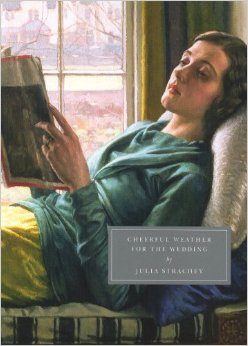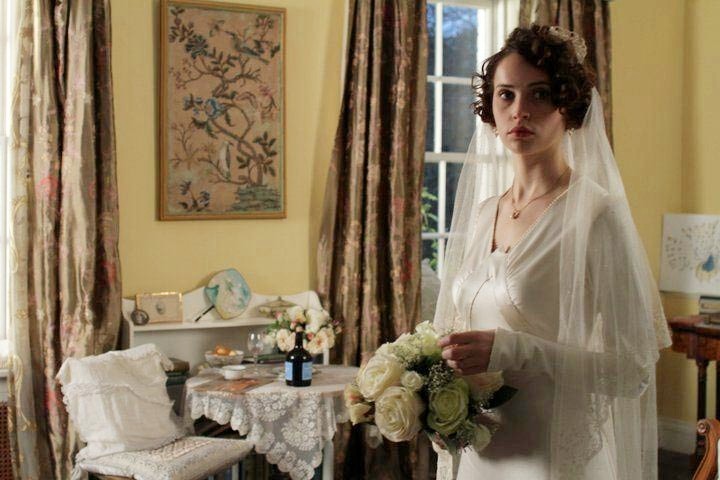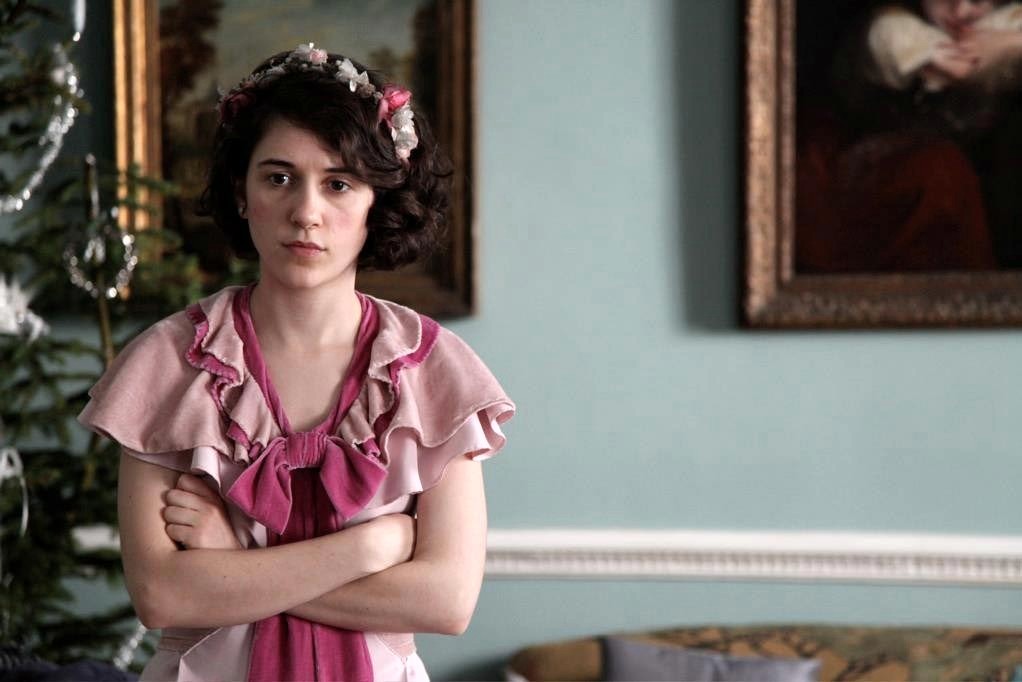Dr Sally Holloway and Jane Mackelworth report on the first meeting of their community book group, exploring love and its history through literature…
Our new ‘Reading Emotions’ community book group aims to engage members of the public with the changing nature of emotions in history, focusing firstly on love in novels by British women c. 1750-1950. As a group, we will be exploring how love has a history, and has ‘meant different things to different people at different moments and has served different purposes’.[1]
 Our first text is Julia Strachey’s Cheerful Weather for the Wedding, initially published in 1932 and since re-issued by Persephone Books. Strachey is perhaps best-known to historians as the niece of Lytton Strachey, founding member of the Bloomsbury Group and author of Eminent Victorians (1918). Cheerful Weather is one of only two novels she completed, written after the breakdown of her first marriage to Stephen Tomlin. It is at once romantic, tragic and funny, creating a number of vivid sketches of relationships between lovers, spouses, mothers and daughters, siblings, and friends.
Our first text is Julia Strachey’s Cheerful Weather for the Wedding, initially published in 1932 and since re-issued by Persephone Books. Strachey is perhaps best-known to historians as the niece of Lytton Strachey, founding member of the Bloomsbury Group and author of Eminent Victorians (1918). Cheerful Weather is one of only two novels she completed, written after the breakdown of her first marriage to Stephen Tomlin. It is at once romantic, tragic and funny, creating a number of vivid sketches of relationships between lovers, spouses, mothers and daughters, siblings, and friends.
The novella is set on the wedding day of twenty-three year old Dolly Thatcham to the Hon. Owen Bigham, who worked in the Diplomatic Service and was eight years her senior (spoilers ahead). As guests arrive for the wedding, the bride considers whether or not to go through with it while gradually draining a bottle of rum. The source of her conundrum is Joseph Patten, an impetuous anthropology student with whom she had spent the previous summer. The novella was recently adapted as a film starring Felicity Jones:
Events are situated in the Thatchams’ country house in Dorset, within a space of roughly six hours. Members of our group commented how the restricted time-frame and single location create a sense of claustrophobia. Dolly spends most of the book shut in her ‘white-enamelled Edwardian bedroom’, while guests arrive downstairs. The house is almost a character itself – readers know far more about it than most of the guests. In one scene, Joseph runs manically around the house looking for Dolly
He clattered off down the main stairway. The landing was empty. He ran despairingly, first to the right, into the sewing-room; then to the left, into the nursery; then back and on down the main stairs into the big hall. There, at last, was Dolly (p. 74).
One of Strachey’s key strengths lies in building suspense. Dolly spends over half of the book preparing for the wedding, leaving our members avidly leafing through the pages to discover whether or not it goes ahead.
Very little detail is provided about the interior lives of characters. This meant our readers did not generally sympathise with Dolly’s predicament, and found the characters to be unlikable. In our discussion, guests were said to be almost zombie-like, as we meet so many people at the wedding but know so little about them. This may have been a deliberate strategy by Strachey, with the wedding party described as ‘more dead than alive’ (p. 90). Conversely, she describes particular objects in excruciating detail, such as a homemade tasselled lamp crafted as a wedding present by a guest (pp. 30-5). Much of the emotional content of the story is carried by objects, such as a Dolly’s long wedding veil ‘stretching away forever’ like her married life (p. 52), and a ‘fusty and repulsive’ Chinese robe hanging before Joseph at the moment of the wedding (p. 78). Meanwhile, Dolly carries her bouquet in one hand and rum in the other (p. 68), representing her two options: an unstable passion with Joseph or respectable married life with Owen.
The novel can be seen as part of a wider movement of middlebrow literature by women, which became popular in the interwar years in Britain. Nicola Humble has shown how these novels were a way for women to explore the changing class and gender identities that middle class women were facing at this time and as such they focused almost exclusively on domestic space, courtship and marriage and class.[2] Humble shows that middlebrow authors such as Elizabeth Bowen used detailed descriptions of the home, and of objects within it, to explore its characters, and particularly female characters.[3]
This can be seen in a scene of sexual tension, highlighted by book group members, in which Dolly knocks an ink bottle over herself, leading Joseph to kneel down and pin a scarf to cover the stain (pp. 75-7). Much like trying to forget her sexual awakening during their summer together, she cannot put the cork back in her bottle of rum. Cheerful Weather brims with tensions that never fully erupt to the surface. One refreshing aspect of the book is that it lacks the dramatic showdown that modern readers might expect.
Throughout the book, characters question the nature of romantic love. Dolly’s awkward seventeen-year old sister Kitty bluntly informs Joseph that “an Englishman in love lacked poetry”:
I told Joseph I envied Barbara McKenzie her Spanish naval officer, who plays to her on his ukulele in the moonlight, and is not ashamed of his love for her. (pp. 57-8)
He retorts that it’s “un-English” for women to seek out such “Continental” romance. Kitty is clearly developing a sense of sexual awareness, discovering how to interact with men. A kind of ‘desperate intenseness’ is said to be her ‘style of the moment with the male sex’ (p. 29).
Kitty’s behaviour is contrasted with Dolly’s. In deciding to go ahead with her marriage to the Hon. Owen Bigham rather than declare her love for Joseph, Dolly can be seen as selecting duty and respectability over love and passion. In some ways this makes her typical of a time when duty was often put before love. Claire Langhamer has argued that while love has always been a factor in selecting a marriage partner, it was only over the course of the twentieth century that the selection of a partner for love alone begun to take precedence over other more practical or material concerns.[4] Langhamer argues that it was during the middle decades of the twentieth century that it became more usual to pursue love alone. She suggests that during these years romantic love also began to be seen as providing transcendental or self-actualizing properties, meaning that it became even more valued above duty.[5] This novel, written in the 1930s takes place just before these shifts in sensibility.
Yet while these more dramatic changes may not have come into place until later in the century, and certainly not in people’s everyday lives which is the focus of Langhamer’s research, this period had nevertheless begun to see a refashioning of marriage and of its potential. The importance of equality and companionship in marriage was emphasised by a number of writers and marriage was increasingly idealised. Marcus Collins has shown that the importance of ‘mutuality’ – which became emphasized in early twentieth century writing on marriage – was based on the idea that true ‘intimacy’ was not possible without equality.[6] This urge to reform marriage had begun in the late eighteenth century. For example, Mary Wollstonecraft, in A Vindication of the Rights of Woman (1792) denounced the separation of men and women, arguing that young people should be educated alongside one another and calling for the notion of companionate marriage.[7] Later thinkers, such as Edward Carpenter, and feminist writers expanded this idea. Carpenter argued at the close of the nineteenth century that marriage should be about seeking the ‘deepest soul union’ between a man and woman.[8] The importance of a shared home life in creating a companionate union was also emphasized. For example, Jane Hume Clapperton wrote in Shafts;
Although essential differences must always exist the sexes will become far more closely united in relations of friendship and sympathy within the safeguarded freedom of a wide home-life full of mutual interests and reciprocal duties.[9]
Yet, what little we know of Dolly’s impending marriage does not appear to offer up a vision of an impending equal or companionable marriage. We know very little of Bigham, and the novel does not paint a picture of intimacy, companionship nor cosy domesticity between Dolly and Bigham. The two seem marked by separateness. And nor does their marriage appear to offer up an example of potential sexual intimacy which was highlighted in changing representations of marriage. Increasingly the role of marriage as a source of sexual union, and sexual pleasure, particularly for women, was emphasised. Elinor Glyn’s popular novel The Philosophy of Love (1923) highlights the spiritual and sexual aspects of marriage, arguing that ‘no union can be perfect without equal capacity for sexual satisfaction in both men and women, as well as capacity for elevation of the soul.’[10] In fact, as Langhamer asserts, marriage was increasingly positioned as a place in which to contain sexual desire and intimacy.[11] Yet Strachey writes against this as she appears to be positioning sexual desire and intimacy outside of marriage, placing it in Dolly’s affair with Joseph, and highlighting her sexual pleasure outside of marriage. In this way the novel can be seen as relatively transgressive, writing against the promised potential of marriage and also against the increasing idealisation of love, and especially married love.
The group’s next book is Memoirs of Emma Courtney (1796), a semi-autobiographical tale of unrequited love by the essayist and radical feminist Mary Hays.
Read more about the ‘Reading Emotions’ book group.
Read Claire Langhamer’s post for this blog on the history of emotions from below.
Read more posts about the history of romantic love.
[1] Claire Langhamer, The English in Love: The Intimate Story of an Emotional Revolution (Oxford, 2013), p. 4.
[2] Nicola Humble, The Feminine Middlebrow Novel, 1920s to 1950s, Class, Domesticity and Bohemianism (Oxford: Oxford University Press, 2001), pp. 5, 11.
[3] Humble, The Feminine Middlebrow Novel, p. 100.
[4] Langhamer, The English in Love, pp. 6, 13.
[5] Langhamer, The English in Love, p.11.
[6] Marcus Collins, Modern Love: An Intimate History of Men and Women in Twentieth-Century Britain (London: Atlantic Books, 2003), p. 5.
[7] Mary Wollstonecraft, A Vindication of the Rights of Woman, 1792 cited in Collins, Modern Love, 2003, p. 4.
[8] Edward Carpenter, Love’s Coming of Age, 1896, revised 1913, p. 15 in Collins, Modern Love, pp. 1-4.
[9] Jane Hume Clapperton, ‘Reform in Domestic Life’, Shafts, 15 June 1893 cited in Collins, Modern Love, p. 26.
[10] Elinor Glyn, The Philosophy of Love, (New York: The Author’s Press, 1923), p. 17.
[11] Langhamer, The English in Love, p. 6.


